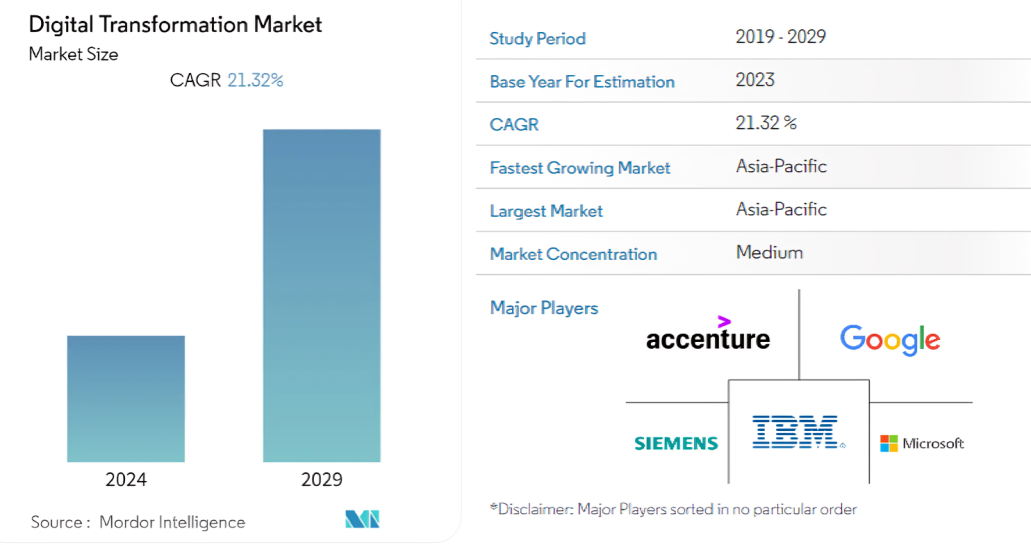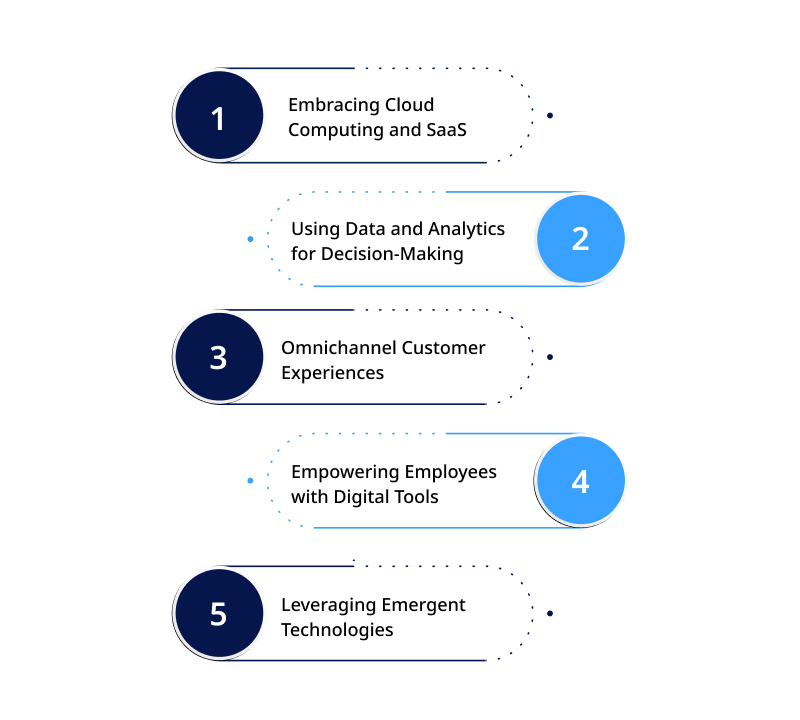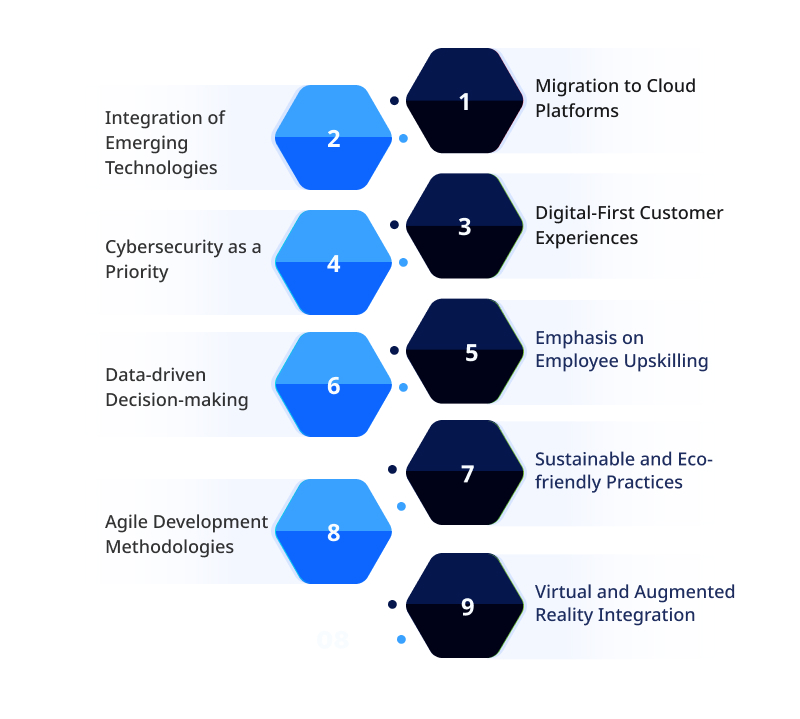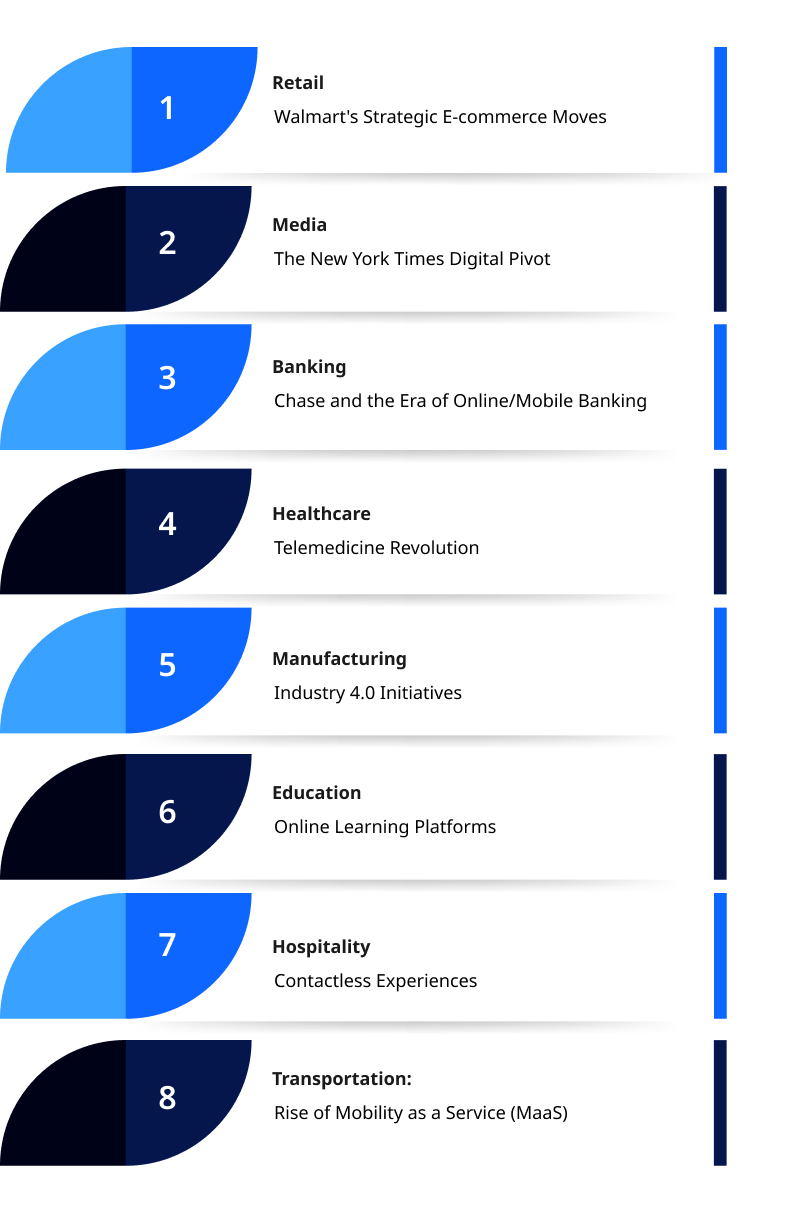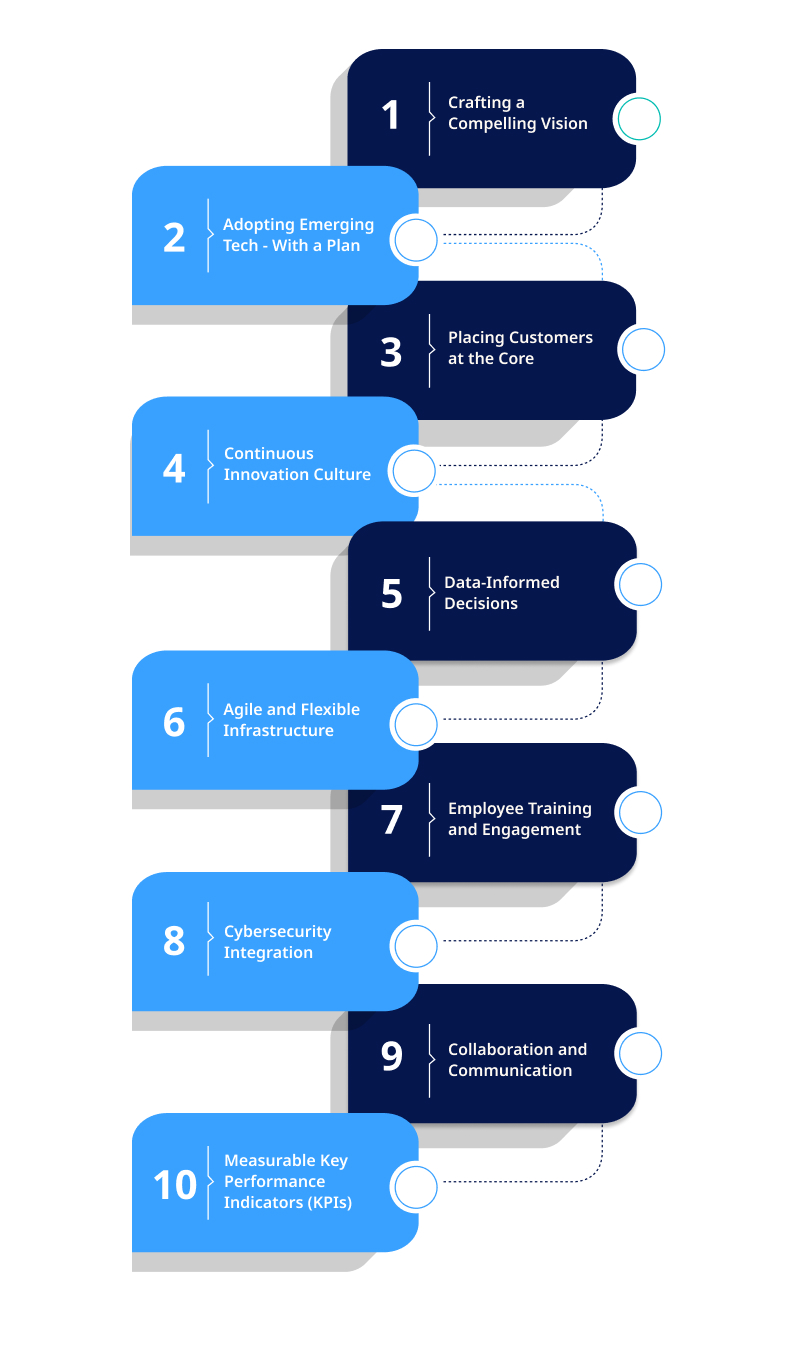Recent research shows the global digital transformation market growing at a breakneck 21.32% CAGR through 2030. Clearly, digital transformation in retail industry is imperative, looking to stay competitive for the long haul.
We see this playing out with major chains like Walmart, which has acquired numerous ecommerce brands to take on the Amazon juggernaut. Specialty players like Sephora now offer augmented reality-powered virtual makeup trials through mobile apps to court younger, digital-savvy audiences.
But successfully “going digital” requires more than just investing in the latest tech tools. Our research with many startups and leading Fortune 500 retailers reveals digital transformation is about strategic reinvention centered around the customer.
This means developing seamless omnichannel capabilities, hyper-personalized engagements, and real-time operations optimization through data analytics. It requires a culture shift, with solid vision and leadership from the executive suite to reimagine the organization for digital-first future technologies.
PixelCrayons' digital transformation strategies help future-proof your business.
This blog will explore examples of top global companies across sectors pursuing holistic digital transformation to remake everything from business models and processes to products and customer experiences. In today’s marketplace, digital transformation is no longer a choice but an imperative.
Table of Contents
Top Companies’ Digital Transformation Strategies
Successful digital transformation is pivotal for innovation, driving organizations to reevaluate operations, processes, and mindsets.
Let’s examine some critical digital transformation strategies deployed by leading enterprises driving innovation:
Embracing Cloud Computing and SaaS
The transition to cloud-based platforms is a cornerstone of digital transformation. Companies like Adobe are opting for cloud-based subscriptions to essential software like Photoshop.
This ensures more flexible user access and allows continuous updates and scalable workflows. The move to cloud computing epitomizes the adaptability required in the digital transformation of the retail industry journey.
Using Data and Analytics for Decision-Making
Data is a valuable asset. Retailers like Target utilize predictive analytics to tailor recommendations, while airlines, exemplified by Delta, employ AI algorithms to adjust fares based on real-time demand forecasts.
This highlights the pivotal role of data analytics in decision-making and underscores the importance of digital transformation in staying ahead.
Omnichannel Customer Experiences
The seamless integration of online, mobile, and offline channels is now a standard in various industries.
Capital One’s approach, enabling customers to bank through web and smartphone apps while having access to physical branches, showcases how companies align their strategies with the evolving digital landscape. This ensures a unified and convenient experience for customers.
Empowering Employees with Digital Tools
Digital transformation isn’t just about customer-facing aspects; it extends to internal processes.
Toyota’s use of virtual reality for employee training and P&G’s adoption of mobile-first platforms for global team collaboration illustrates how digital tools enhance organizational efficiency. This emphasizes the human-centric aspect of digital transformation services.
Leveraging Emergent Technologies
Innovation is at the core of how companies reinvent themselves digitally. Take Disney and Toyota as examples.
Disney is applying cutting-edge 3D printing technology in its theme park design process to optimize the guest experience. Auto giant Toyota is exploring future-forward solutions like blockchain, robotics, and artificial intelligence to build more reliable and efficient vehicles.
These emergent, often experimental technologies showcase how digital transformation fuels business innovation. Of course, there’s no one-size-fits-all tech mix for reinvention.
Cloud platforms, advanced data analytics, omnichannel customer experiences, and digital tools are also part of the equation. Companies combine a strategic blend of established and emerging capabilities to pave the way for transformational innovation.
Our analysts provide custom roadmaps to transform your company digitally.
Digital transformation has become imperative to stay competitive. Specialist services to guide and accelerate this transformation have thus become critical to shaping the future technologies trajectory of retailers and other businesses in an increasingly digital-first world.
The companies that continue reinventing themselves at the cutting edge can define the next era of their industries.
Digital Transformation Key Trends
Businesses are shaped by many significant digital transformation trends in the constantly changing.
About the dynamic digital transformation in the retail industry in particular, these trends highlight the significance of a digital transformation strategy and provide industry guidance for future technologies.
Migration to Cloud Platforms
The first and foremost trend propelling organizations towards agility is the migration to cloud platforms. This strategic move enables businesses to scale operations seamlessly, ensuring enhanced flexibility and efficiency.
In the retail sector, this shift translates into more responsive and scalable infrastructures, aligning with the imperative of digital transformation.
Integration of Emerging Technologies
Incorporating developing technology is a fundamental feature that characterizes the digital landscape. Machine learning (ML), artificial intelligence (AI), and the Internet of Things (IoT) are becoming essential to operations.
The digital transformation in the retail industry can tailor customer experiences, optimize supply chain operations, and make data-driven decisions using these cutting-edge technologies. It is a strategic necessity, not just a trend, to maintain competitiveness.
Digital-First Customer Experiences
There is a paradigm change happening with a focus on digital-first consumer experiences. The main idea behind this movement is to connect with customers wherever they are—online, on mobile, and through various digital channels.
This means businesses must create smooth, customized shopping experiences from browsing to buying. It emphasizes the significance of digital transformation in building more robust relationships with tech-savvy customers.
Cybersecurity as a Priority
The significance of cybersecurity becomes apparent as more companies utilize digital channels. Digital assets, client data, and sensitive data must all be protected.
Since customer trust is essential to a successful digital transformation in retail industry, ensuring robust cybersecurity safeguards is not just a fad.
Data-driven Decision-making
Companies are moving towards data-driven decision-making as a result of the data explosion. Leveraging analytics’ potential improves operations, foretells client demands, and yields insightful information.
Embodying the mutually beneficial relationship between digital transformation and innovation entails customizing inventory, marketing strategies, and consumer interactions in the retail sector based on real-time data.
Emphasis on Employee Upskilling
Employee upskilling is becoming more and more critical as cutting-edge technology is incorporated. Workers must possess the necessary skills to utilize and navigate new technologies effectively.
This trend guarantees that workers can function effectively in an increasingly digital workplace, aligning with digital transformation concepts, especially in the retail industry, where a human touch is crucial.
Sustainable and Eco-friendly Practices
One significant trend gaining traction is using ecologically friendly and sustainable methods. Retail demonstrates this by implementing eco-friendly procedures, cutting carbon footprints, and committing to sustainable supplier chains.
It exhibits a progressive mindset that aligns with the more prominent themes of sustainability and corporate responsibility, going beyond mere compliance.
Agile Development Methodologies
Agile development approaches are necessary because of the necessity for quick adaptation. This trend will enable businesses to swiftly adapt to market changes, client needs, and technological advancements.
Agility is the ability to launch products faster, modify marketing plans, and react quickly to changing customer preferences in the digital transformation in retail industry.
Virtual and Augmented Reality Integration
Virtual and augmented reality integration is becoming more popular. This translates to virtual try-ons, increased product visualization, and engaging shopping experiences in retail.
This pattern raises consumer interaction and illustrates how future technologies have the power to change the way people shop entirely.
PixelCrayons aligns emerging tech with your business vision and goals.
These new digital transformation trends, taken together, essentially enhance the digital transformation landscape by providing businesses with an all-encompassing perspective of the technology and tactics that will shape the future.
A comprehensive strategy to these trends guarantees an organization’s survival and prosperity in the digital era as they traverse this ever-changing landscape.
Digital Transformation in Action Across Industries
Digital transformation is a widespread phenomenon influencing the tactics of many different industries rather than being limited to just one. Let us examine how companies across many sectors are charting their course in the digital era.
Retail: Walmart’s Strategic E-commerce Moves
Walmart has deliberately embraced change in digital transformation in the retail industry. Acquiring multiple e-commerce enterprises was a revolutionary move made by Walmart, as it recognized the shifting marketplace dominated by e-commerce giants such as Amazon.
This bold approach highlights the importance of digital transformation plan to maintain competitiveness. By showcasing their willingness to adopt new technologies, Walmart’s acquisition strategy positions them at the forefront of innovation.
Media: The New York Times Digital Pivot
The media industry landscape changes immensely as consumer behaviors shift to digital platforms. Adapting quickly has been vital to the survival of traditional outlets like The New York Times.
The Times astutely recognized years ago that an existential reckoning was coming for print news. As online and mobile news consumption grew exponentially, standing still was not an option if they wanted to continue delivering journalism to readers.
So, in one of the boldest moves a legacy newspaper has made, they decided to embrace the digital transition entirely rather than play defense. The Times pivoted to an all-access subscription model for their digital content, placing a big bet on readers’ willingness to pay for quality journalism even on screens.
Banking: Chase and the Era of Online/Mobile Banking
Chase and other financial institutions are leading the way in digital transformation strategy inside the banking industry. Challenging the digital revolution, Chase has defended mobile and online banking, catering to the needs of an informed customer base.
This change highlights a broader trend in the banking sector. It highlights the necessity of a holistic digital transformation strategy to remain competitive in a financial environment that is becoming increasingly digital.
Healthcare: Telemedicine Revolution
Telemedicine adoption stands out as a game-changing development in the healthcare industry.
Organizations like the Cleveland Clinic and Mayo Clinic have utilized digital technologies to offer remote consultations and healthcare services.
This demonstrates that digital transformation is vital to improving patient care and making healthcare services more accessible.
Manufacturing: Industry 4.0 Initiatives
With the advent of Industry 4.0 technology, the industrial sector is experiencing a paradigm shift.
Businesses like Siemens and General Electric use automation, artificial intelligence, and the Internet of Things to streamline their manufacturing processes.
This is a prime example of how incorporating emerging technologies is essential to maintaining competitiveness in the contemporary manufacturing environment.
Education: Online Learning Platforms
In education, online learning platforms have become the norm. Institutions like Coursera and edX have revolutionized the way people access education globally.
This shift underscores the digital transformation strategy in education, emphasizing the need for flexibility and accessibility in learning.
Hospitality: Contactless Experiences
Providing frictionless experiences is the main goal in the hospitality industry. Mobile check-ins, digital room keys, and personalized services via mobile apps are being implemented by hotels such as Marriott and Hilton.
This demonstrates the industry’s dedication to providing digitally first consumer experiences and adjusting to emerging technology to enhance customer happiness.
Transportation: Rise of Mobility as a Service (MaaS)
Mobility as a Service (MaaS) is the new wave in the transportation business. Companies like Uber and Lyft are revolutionizing people’s commute by integrating many modalities into a single digital platform.
This represents a more widespread trend in the sector towards using digital integration to improve consumer experiences.
We help leading enterprises across industries drive innovation.
These diverse industry examples highlight that the impact of digital transformation is universal.
Organizations that prioritize a complete digital transformation and innovation plan and strategically embrace future technologies, regardless of their industry—healthcare, manufacturing, education, hospitality, or transportation—are better positioned to succeed in our quickly changing digital landscape.
Navigating the Digital Transformation in Retail
Transitioning to a digital business model is no small feat in retail. It requires strategic vision and commitment across the organization.
From our work helping leading retailers evolve through digital transformation challenges, a few elements rise to the top as indispensable for success:
Crafting a Compelling Vision
Leadership needs to set a clear, inspiring vision and rally the company behind it. This long-term roadmap clarifies direction so teams can confidently align and execute digital initiatives, understanding how they connect to an overarching goal.
Adopting Emerging Tech – With a Plan
Digital transformation necessitates integrating innovative technologies into operations and culture. But tech, for tech’s sake, falls flat.
Companies thrive when departments systematically adopt solutions that help create better customer and employee experiences. Think – omnichannel commerce, personalized marketing, immersive virtual storefronts.
Placing Customers at the Core
Ultimately, companies must undergo digital transformation with customers at the center.
In retail, this means using data and UX best practices to offer seamless, personalized shopping across in-store, online, and mobile – holistically understanding preferences and pain points across touchpoints.
Continuous Innovation Culture
Digital transformation doesn’t end after an initial round of new platforms and apps.
Leading companies know tech and trends evolve relentlessly. Retailers can turn adaptation into a competitive advantage by experimenting with bleeding-edge tools like AI and VR, gathering user feedback, and iterating quickly.
Data-Informed Decisions
Insights derived from customer analytics, market trends, and operational data should drive decision-making.
Retailers who can harness data to predict demand, tailor inventories, and supply chains, and provide individualized promotions will be best positioned to delight customers.
The companies that check all these strategic boxes will thrive amidst digital disruption.
Agile and Flexible Infrastructure
Building an agile and flexible infrastructure is vital for adaptability. Future-proofing operations require a tech architecture that can swiftly respond to changes.
Cloud-based solutions and modular systems enable scalability, allowing businesses to navigate evolving market dynamics without being hindered by rigid structures.
Employee Training and Engagement
Empowering the workforce with adequate training is as critical as implementing digital tools. Employees must be proficient in using new technologies and aligned with the broader vision.
A continuous learning and adaptation culture fosters an environment where employees become active contributors to the digital transformation journey.
Cybersecurity Integration
In an increasingly digital landscape, safeguarding sensitive information is paramount.
The digital transformation strategy must encompass robust cybersecurity measures. In the retail sector, where customer trust is paramount, protecting personal data and ensuring secure transactions are integral to a successful transformation.
Collaboration and Communication
It is essential to foster a culture of collaboration and communication. Digital transformation includes breaking down silos and promoting cross-functional collaboration.
This collaborative spirit ensures that insights and innovations flow seamlessly across departments, preventing bottlenecks and fostering a holistic approach.
Measurable Key Performance Indicators (KPIs)
Setting measurable Key Performance Indicators (KPIs) is essential for tracking progress and success. Clear metrics allow organizations to assess the impact of digital initiatives objectively.
Whether improving customer satisfaction, reducing operational costs, or increasing sales, defining and measuring KPIs ensures that the transformation stays on course.
Have our team assess your digital maturity and build the perfect roadmap.
In essence, a comprehensive digital transformation strategy in the retail industry encompasses technological aspects and cultural, organizational, and strategic dimensions.
These additional pointers enhance the depth and resilience of the transformation, positioning organizations for sustained success in the dynamic digital landscape.
Conclusion
Companies can also meet customer needs seamlessly across physical and digital touchpoints by leveraging innovations like AI, ML, and IoT to spark growth. While future technologies require an upfront investment, they equip companies to better compete at scale over the long term.
Ultimately, digital transformation in the retail industry is not an option but an imperative for reinventing business in the 21st century. Digital transformation unlocks innovation, more innovative operations, and closer customer connections. However, companies must continually assess and iterate their technology strategy. Partnering with specialists can accelerate digital maturity.
At PixelCrayons, our full-stack digital transformation services help you set and achieve measurable digital goals, adopt the optimal emerging tech stack, drive continual optimization through data, and enable invention through agile delivery models.
Contact us today to explore how we can reignite your company’s growth through digital reinvention.

